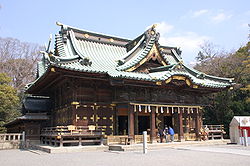- Mishima Taisha
-
Mishima Taisha
三嶋大社
Honden of Mishima Taisha Information Type Mishima shrine Dedicated to Mishima Daimyōjin Address 2-1-5 Omiya-chō, Mishima, Shizuoka, 411-0035 Phone 055-975-0172 Website Homepage The Mishima Taisha (三嶋大社) is a Shinto shrine in the city of Mishima in Shizuoka Prefecture, Japan. It is the ichinomiya of former Izu Province. The main festival of the shrine is held annually on August 16, and features yabusame performances.[1]
Contents
Enshrined kami
The primary kami of Mishima Taisha is the Mishima Daimyōjin (三嶋大明神), an amalgamation of Ōyamatsu-no-mikoto (大山祇命) and his consort Tsumihayae Kotoshironushi no kami (積羽八重事代主神)
Mishima Taisha also has numerous small subsidiary shrines dedicated to various kami within its precincts.
History
The date of Mishima Taisha’s foundation is unknown. Per shrine tradition and Nara period records, the predecessor of the shrine was originally located on Miyakejima but was transferred later from place to place, including Shimoda, and Ohito, before being moved to the present site. In the early Heian period Engishiki records, the shrine is referred to as “Izu Mishima Shrine" located in Kamo county, which is in the southern part of Izu Peninsula.
After the establishment of Izu Province in the mid-Heian period, with its capital located near modern Numazu, the shrine was transferred to its present location, and initially was referred to as the “Shingu” (new shrine).
After he was exiled to Izu, Minamoto Yoritomo worshipped at Mishima Taisha for divine assistance in his struggle to overthrow the Heike clan in the Gempei War. After the successful establishment of the Kamakura Shogunate, he rebuilt the shrine on a large scale, and worship of the Mishima Daimyōjin became popular with the samurai class. During the Sengoku period the kami of Mishima Taisha came to be associated with victory in battle, and the shrine was patronized by the Odawara Hōjō, the Imagawa clan and the Tokugawa clan.
During the Edo period, Mishima Taisha and its associated post town of Mishima-shuku prospered as a popular pilgrimage stop on the Tōkaidō highway between Edo and Kyoto. Its torii gate was depicted in an ukiyoe by Ando Hiroshige. A calendar issued by the shrine was carried home by pilgrims from all over Japan, and was known as the “Mishima Calendar.”
From 1871 through 1946, the Mishima Taisha was officially designated one of the Kanpei-taisha (官幣大社), meaning that it stood in the first rank of government supported shrines.[2]
Notable structures
The Honden, a three-bay nagare-zukuri style building, has been reconstructed numerous times over the history of the shrine. The current building dates from 1866, having been rebuilt after the shrine was flattened in the Ansei Tōkai Earthquake of 1854. It is registered as a National Important Cultural Property.
Cultural properties
Mishima Taisha has a small museum. The most important object is a Japanese lacquerware wooden box with maki-e decoration. The box contains numerous utensils and articles used for women’s cosmetics in the late Heian period and was donated to the shrine by Hōjō Masako. It is listed as one of the National Treasures of Japan.[3]
In addition its Honden, Mishima Taisha also has four other items which are registered as National Important Cultural Properties:
- Kamakura-period tachi (Japanese sword) donated to the shrine by Emperor Meiji.
- Muromachi period wakizashi short sword
- A copy of the Heart Sutra dated 1203, written by Minamoto no Yoritomo
- A collection of 592 documents of shrine records from the Heian through Edo periods.
In addition, a 1200-year old Osmanthus fragrans tree in the shrine precincts is protected by the national government as a natural monument.
See also
- List of Shinto shrines
- List of National Treasures of Japan (crafts-others)
Notes
References
- Earle, Joe. (2005). Splendors of Imperial Japan. The Khalili Collections. 10-ISBN 1-874-78019-6
- Maas, Jeffrey P. (1999). Yoritomo and the Founding of the First Bakufu: The Origins of Dual Government in Japan. Stanford: Stanford University Press.10-ISBN 0-804-73591-3
- Plutschow, Herbe. (1996). Matsuri: The Festivals of Japan. London: RoutledgeCurzon. 10-ISBN 1-873-41063-8
- Ponsonby-Fane, Richard Arthur Brabazon. (1959). The Imperial House of Japan. Kyoto: Ponsonby Memorial Society. OCLC 194887
Coordinates: 35°07′19″N 138°55′08″E / 35.12194°N 138.91889°E
Shinto shrine Shinto architecture Buildings - chōzuya or temizuya
- haiden
- heiden
- hokora
- honden / shinden / shōden
- kagura-den
- massha
- sessha
Architectonic elements Styles - hirairi-zukuri
- tsumairi-zukuri
- gongen-zukuri
- hachiman-zukuri
- hiyoshi-zukuri
- irimoya-zukuri
- ishi-no-ma-zukuri
- kasuga-zukuri
- kibitsu-zukuri
- misedana-zukuri
- nagare-zukuri
- ōtori-zukuri
- owari-zukuri
- ryōnagare-zukuri
- shinmei-zukuri
- sumiyoshi-zukuri
- taisha-zukuri
Others Implements Main kami Staff Head shrines1 - Fushimi Inari Taisha
- Usa Hachiman-gū
- Ise Grand Shrine
- Dazaifu Tenman-gū
- Munakata Taisha
- Suwa Taisha
- Hiyoshi Taisha
- Kumano Nachi Taisha
- Tsushima Shrine
- Yasaka Shrine
Miscellaneous 1 (in order of the size of the shrine network they head)
Categories:- Shinto shrines in Shizuoka Prefecture
Wikimedia Foundation. 2010.
